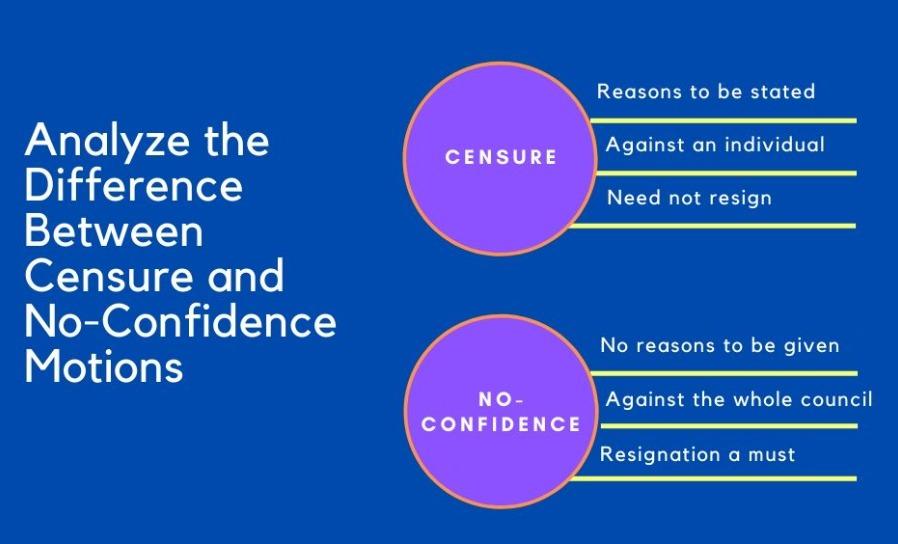Table of Contents
A censure is a formal statement of disapproval against a member of the government or the government itself, but it doesn’t necessarily lead to resignation. A no-confidence motion, however, is a more severe action indicating that the legislative body no longer has faith in the government’s ability to govern, often leading to the government’s resignation and potential new elections. This article will explain the difference between censure and no-confidence motions for the IAS Exam.
Difference Between Censure and No-Confidence Motion
The difference between a censure motion and a no-confidence motion lies in their consequences: a censure motion does not require the ministry to resign, whereas a no-confidence motion mandates the resignation of the entire ministry. This explanation provides comprehensive details on the censure motion and relevant aspects. For a clearer understanding of the differences between censure motion and no-confidence motion, refer to the information provided below.
| Aspect | Censure |
No-Confidence Motion
|
| Definition | A formal statement of disapproval aimed at government officials or the government. |
A parliamentary motion indicating that the legislative body has lost faith in the government’s ability to govern.
|
| Consequences | Does not necessarily lead to the resignation of officials or the government. |
If passed, usually requires the government to resign.
|
| Implication for Government | Signifies disapproval of actions or policies, but allows the government to remain in power. |
Indicates a loss of parliamentary support, potentially leading to the formation of a new government or elections.
|
| Frequency of Use | Can be more common as it’s less drastic than a no-confidence motion. |
Used in more serious circumstances when there’s a significant lack of faith in the government.
|
| Impact | Primarily symbolic, showing disapproval without forcing a change in leadership. |
Has a direct impact on the government’s tenure, possibly leading to its dissolution.
|

What is Censure Motion?
A censure motion is a formal expression of disapproval in a parliamentary system. Here are its key features in point form:
- Definition: A censure motion is a formal statement issued by a legislative body, expressing disapproval of the actions or policies of a member of the government or the government itself.
- Non-binding: Unlike a no-confidence motion, a censure motion does not require the government to resign if it passes. It is primarily symbolic.
- Target: It can be directed towards individual government officials or the entire government.
- Procedure: Typically involves the proposal of the motion by a member of the legislature, followed by a debate, and then a vote. A majority approval is usually needed for the motion to pass.
- Consequences: While it does not legally compel any action, a passed censure motion signifies the legislative body’s disapproval and can impact public opinion and the credibility of the targeted individual(s) or the government.
- Purpose: Serves to express dissatisfaction with certain actions or policies, to hold the government or its members accountable, and to signal the need for change in behaviour or policy direction.
- Impact: Although largely symbolic, the political impact of a censure motion can be significant, affecting the reputation and effectiveness of those censured.
- Use of Censure motions: Censure motions are used more frequently than no-confidence motions, as they are less disruptive and do not lead to the dissolution of the government or mandatory elections.
What is No-Confidence Motion
A no-confidence motion is a critical parliamentary mechanism used within various democratic systems around the world. It represents a formal challenge to the current government’s ability to rule and is a testament to the principle of accountability in parliamentary democracies. Here are the essential aspects of a no-confidence motion:
- Definition: A no-confidence motion is a statement or resolution brought by members of the legislature expressing that they do not have confidence in the government or its leader’s ability to govern effectively.
- Consequence: The primary consequence of a successful no-confidence motion is significant: it typically requires the government, including the Prime Minister or equivalent head of government, to resign. This can lead to the formation of a new government or trigger national elections.
- Purpose: Its purpose is to ensure that the government retains the majority support of the legislative body. This mechanism prevents a government that has lost the legislature’s support from continuing in power, thus reflecting the foundational democratic principle that the government must have the consent of the governed (as represented by the legislature).
- Process: The process to initiate a no-confidence motion varies by country but generally requires a member of the legislature to propose the motion, which is then debated. A vote is held, and if a majority of the members vote in favor of the motion, it is passed, leading to the government’s resignation.
- Strategic Use: While the no-confidence motion is a tool for ensuring accountability, it can also be used strategically by opposition parties to challenge the government’s mandate, especially in times of controversy or when the government appears weak.
- Variations: The specifics of how a no-confidence motion works, including the required majority and procedural details, can vary widely between different countries and their respective parliamentary systems.
- Impact: Beyond the immediate political implications, the successful passage of a no-confidence motion can have profound effects on a country’s political landscape, often leading to early elections and significant changes in policy direction depending on the new government formed.
A no-confidence motion is, therefore, a powerful parliamentary tool that underscores the importance of government accountability to the legislative body and, by extension, to the citizens it represents.



 UPSC Eligibility Criteria 2024- Age Limi...
UPSC Eligibility Criteria 2024- Age Limi...
 UPSC Prelims Exam Date 2024, Check New E...
UPSC Prelims Exam Date 2024, Check New E...
 UKPSC RO ARO Result 2024 Out, Download M...
UKPSC RO ARO Result 2024 Out, Download M...







